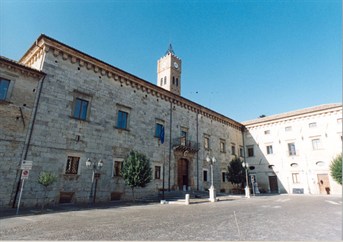The Abruzzo heart of the Duchy: Atri and Palazzo Acquaviva (first part)
 The town of Atri was sold in 1395 for 35,000 ducats to the Count of San Flaviano, Antonio Acquaviva, and remained in the family until 1760, when it came under the direct rule of the King of Naples. It was the capital of the so-called State of Atri, which included a large number of lands and towns situated in the current province of Teramo. The Ducal Palace of Atri, now the Town Hall, has for decades been the privileged place of residence of the Acquaviva family. Designed as a true “small court“, the dukes lived there, at least until the mid-sixteenth century, together with their family, servants, counselors, officers, soldiers, administrators, and it seems that even Cervantes, secretary to Claudio Acquaviva had been there for some time. Originally “royal houses”, which were built on the ruins of the baths, the portico, the “capitolium” of the Roman city, which had been donated to the Dominicans by Charles II of Anjou, they came into the possession of the Acquaviva at the end of the fourteenth century, when Antonio Acquaviva, the first duke, began their transformation into a veritable palace. He obeyed the typical characteristics of defensive castles, adopting a rectangular plan with a courtyard in the centre. At the beginning of the fifteenth century, therefore, the palace had an austere and militaristic look to it and it was not the headquarters of the Acquaviva. It was with Giosia I in the second half of the fifteenth century, that the building was made to conform to the standards of the day for the dwellings of the nobility. The duke, in fact, took care to strengthen the building and to decorate the vast halls of the building with frescoes by Giacomo d’Atri, Giovanni de Varesis and Andrea de Litio, none of which have survived. At the beginning of the sixteenth century, as a serious political crisis affected the Acquaviva family, the palace was abandoned and fell into deep decline. It was only with Andrea Matteo III, that the family returned to play a prominent political role in the kingdom and Giovanni Antonio Donato, VIII Duke of Atri, began a decisive new phase of construction in the second half of the sixteenth century, which gave the building the appearance that it still has today. Anonymous yet praiseworthy architects and craftsmen were summoned to this end.
The town of Atri was sold in 1395 for 35,000 ducats to the Count of San Flaviano, Antonio Acquaviva, and remained in the family until 1760, when it came under the direct rule of the King of Naples. It was the capital of the so-called State of Atri, which included a large number of lands and towns situated in the current province of Teramo. The Ducal Palace of Atri, now the Town Hall, has for decades been the privileged place of residence of the Acquaviva family. Designed as a true “small court“, the dukes lived there, at least until the mid-sixteenth century, together with their family, servants, counselors, officers, soldiers, administrators, and it seems that even Cervantes, secretary to Claudio Acquaviva had been there for some time. Originally “royal houses”, which were built on the ruins of the baths, the portico, the “capitolium” of the Roman city, which had been donated to the Dominicans by Charles II of Anjou, they came into the possession of the Acquaviva at the end of the fourteenth century, when Antonio Acquaviva, the first duke, began their transformation into a veritable palace. He obeyed the typical characteristics of defensive castles, adopting a rectangular plan with a courtyard in the centre. At the beginning of the fifteenth century, therefore, the palace had an austere and militaristic look to it and it was not the headquarters of the Acquaviva. It was with Giosia I in the second half of the fifteenth century, that the building was made to conform to the standards of the day for the dwellings of the nobility. The duke, in fact, took care to strengthen the building and to decorate the vast halls of the building with frescoes by Giacomo d’Atri, Giovanni de Varesis and Andrea de Litio, none of which have survived. At the beginning of the sixteenth century, as a serious political crisis affected the Acquaviva family, the palace was abandoned and fell into deep decline. It was only with Andrea Matteo III, that the family returned to play a prominent political role in the kingdom and Giovanni Antonio Donato, VIII Duke of Atri, began a decisive new phase of construction in the second half of the sixteenth century, which gave the building the appearance that it still has today. Anonymous yet praiseworthy architects and craftsmen were summoned to this end.
